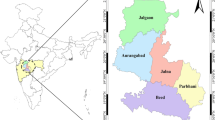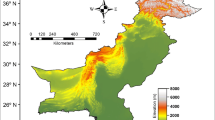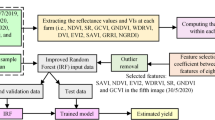Abstract
Precise and timely prediction of crop yields is crucial for food security and the development of agricultural policies. However, crop yield is influenced by multiple factors within complex growth environments. Previous research has paid relatively little attention to the interference of environmental factors and drought on the growth of winter wheat. Therefore, there is an urgent need for more effective methods to explore the inherent relationship between these factors and crop yield, making precise yield prediction increasingly important. This study was based on four type of indicators including meteorological, crop growth status, environmental, and drought index, from October 2003 to June 2019 in Henan Province as the basic data for predicting winter wheat yield. Using the sparrow search algorithm combined with random forest (SSA-RF) under different input indicators, accuracy of winter wheat yield estimation was calculated. The estimation accuracy of SSA-RF was compared with partial least squares regression (PLSR), extreme gradient boosting (XG-Boost), and random forest (RF) models. Finally, the determined optimal yield estimation method was used to predict winter wheat yield in three typical years. Following are the findings: 1) the SSA-RF demonstrates superior performance in estimating winter wheat yield compared to other algorithms. The best yield estimation method is achieved by four types indicators’ composition with SSA-RF) (R2 = 0.805, RRMSE = 9.9%. 2) Crops growth status and environmental indicators play significant roles in wheat yield estimation, accounting for 46% and 22% of the yield importance among all indicators, respectively. 3) Selecting indicators from October to April of the following year yielded the highest accuracy in winter wheat yield estimation, with an R2 of 0.826 and an RAISE of 9.0%. Yield estimates can be completed two months before the winter wheat harvest in June. 4) The predicted performance will be slightly affected by severe drought. Compared with severe drought year (2011) (R2 = 0.680) and normal year (2017) (R2 = 0.790), the SSA-RF model has higher prediction accuracy for wet year (2018) (R2 = 0.820). This study could provide an innovative approach for remote sensing estimation of winter wheat yield, yield.
Similar content being viewed by others
References
An G Q, Jiang Z Y, Cao X et al., 2021. Short-term wind power prediction based on particle swarm optimization-extreme learning machine model combined with AdaBoost algorithm. IEEE Access, 9: 94040–94052. doi: https://doi.org/10.1109/ACCESS.2021.3093646
Awadallah M A, Al-Betar M A, Doush I A et al., 2023. Recent versions and applications of sparrow search algorithm. Archives of Computational Methods in Engineering, 30(5): 2831–2858. doi: https://doi.org/10.1007/s11831-023-09887-z
Bai Q H, 2010. Analysis of particle swarm optimization algorithm. Computer and Information Science, 3(1): 180. doi: https://doi.org/10.5539/cis.v3n1p180
Beck H E, Pan M, Miralles D G et al., 2021. Evaluation of 18 satellite-and model-based soil moisture products using in situ measurements from 826 sensors. Hydrology and Earth System Sciences, 25(1): 17–40. doi: https://doi.org/10.5194/hess-25-17-2021
Chen G B, Li S S, Knibbs L D et al., 2018. A machine learning method to estimate PM2.5 concentrations across China with remote sensing, meteorological and land use information. Science of the Total Environment, 636: 52–60. doi: https://doi.org/10.1016/j.scitotenv.2018.04.251
Chen T Q, Guestrin C, 2016. Xgboost: A scalable tree boosting system. In: Proceedings of the 22nd ACM SIGKDD International Conference on Knowledge Discovery and Data Mining. San Francisco: ACM, 785–794. doi: https://doi.org/10.1145/2939672.2939785
Chen Y, Lee W S, Gan H et al., 2019. Strawberry yield prediction based on a deep neural network using high-resolution aerial orthoimages. Remote Sensing, 11(13): 1584. doi: https://doi.org/10.3390/rs11131584
Chen Y, Liu Z Y, Xu C X et al., 2022. Heavy metal content prediction based on random forest and sparrow search algorithm. Journal of Chemometrics, 36(10): e3445. doi: https://doi.org/10.1002/cem.3445
Cheng M H, Penuelas J, McCabe M F et al., 2022. Combining multi-indicators with mactane-learning algorithms for maize yield early prediction at the county-level in China. Agricultural and Forest Meteorology, 323: 109057. doi: https://doi.org/10.1016/j.agrformet.2022.109057
Cogato A, Meggio F, De Antoni Migliorati M et al., 2019. Extreme weather events in agriculture: a systematic review. Sustainability, 11(9): 2547. doi: https://doi.org/10.3390/su11092547
Cole M B, Augustin M A, Robertson M J et al., 2018. The science of food security, npj Science of Food, 2(14). doi: https://doi.org/10.1038/s41538-018-0021-9
Dechant B, Ryu Y, Kang M, 2019. Making full use of hyperspectraldata for grossprimary productivity estimation with multivariate regression: mechanistic insights from observations and process-based simulations. Remote Sensing of Environment, 234: 111435. doi: https://doi.org/10.1016/j.rse.2019.111435
Ding Y X, Peng S Z, 2021. Spatiotemporal change and attribution of potential evapotranspiration over China from 1901 to 2100. Theoretical and Applied Climatology, 145(1): 79–94. doi: https://doi.org/10.1007/s00704-021-03625-w
Feng P Y, Wang B, Li D L et al., 2020. Dynamic wheat yield forecasts are improved by a hybrid approach using a biophysical model and machine learning technique. Agricultural and Forest Meteorology, 285–286: 107922. doi: https://doi.org/10.1016/j.agrformet.2020.107922
Gavahi K, Abbaszadeh P, Moradkhani H, 2021. Deep Yield: a combined convolutional neural network with long short-term memory for crop yield forecasting. Expert Systems With Applications, 184:115511. doi: https://doi.org/10.1016/j.eswa.2021.115511
Gharehchopogh F S, Namazi M, Ebrahimi L et al., 2022. Advances in sparrow search algorithm: a comprehensive survey. Archives of Computational Methods in Engineering: State of the Art Reviews, 30(1): 427–4155. doi: https://doi.org/10.1007/s11831-022-09804-w
Guo Long, Zhang Haitao, Chen Yiyun et al., 2019. Combining Environmental Factors and Lab VNIR Spectral Data to Predict SOM by Geospatial Techniques. Chinese Geographical Science, 29(2): 258–269. doi: https://doi.org/10.1007/s11769-019-1020-8
Guo M, Li J, Huang S B et al., 2020. Feasibility of using MODIS products to simulate sun-induced chlorophyll fluorescence (SIF) in boreal forests. Remote Sensing, 12(4): 680. doi: https://doi.org/10.3390/rs12040680
Han J C, Zhang Z, Cao J et al., 2020. Prediction of winter wheat yield based on multi-source data and machine learning in China. Remote Sensing, 12(2): 236. doi: https://doi.org/10.3390/rs12020236
Javed T, Li Y, Rashid S et al., 2021. Performance and relationship of four different agricultural drought indices for drought monitoring in China’s mainland using remote sensing data. Science of The Total Environment, 759: 143530. doi: https://doi.org/10.1016/j.scitotenv.2020.143530
Jeong J H, Resop J P, Mueller N D et al., 2016. Random forests for global and regional crop yield predictions. PLoS One, 11(6): e0156571. doi: https://doi.org/10.1371/journal.pone.0156571
Kaiser D P, Qian Y, 2002. Decreasing trends in sunshine duration over China for 1954–1998: indication of increased haze pollution? Geophysical Research Letters, 29(21): 42042. doi: https://doi.org/10.1029/2002GL016057
Kanevski M, Parkin R, Pozdnukhov A et al., 2004. Environmental data mining and modeling based on machine learning algorithms and geostatistics. Environmental Modelling and Software, 19(9): 845–855. doi: https://doi.org/10.1016/j.envsoft.2003.03.004
Kasampalis D A, Alexandridis T K, Deva C et al., 2018. Contribution of remote sensing on crop models: a review. Journal of Imaging, 4(4): 52. doi: https://doi.org/10.3390/jimaging4040052
Kleyn F J, Ciacciariello M, 2021. Future demands of the poultry industry: will we meet our commitments sustainably in developed and develo** economies? World’s Poultry Science Journal, 77(2): 267–278. doi: https://doi.org/10.1080/00439339.2021.1904314
Li X, **ao J F, 2019. A global, 0.05-degree product of solar-induced chlorophyll fluorescence derived from OCO-2, MODIS, and reanalysis data. Remote Sensing, 11(5): 517. doi: https://doi.org/10.3390/rs11050517
Luo G, 2016. A review of automatic selection methods for machine learning algorithms and hyper-parameter values. Network Modeling Analysis in Health Informatics and Bioinformatics, 5(1): 18. doi: https://doi.org/10.1007/s13721-016-0125-6
Luo Y C, Zhang Z, Chen Y et al., 2020. ChinaCropPhen1km: a high-resolution crop phenological dataset for three staple crops in China during 2000–2015 based on leaf area index (LAI) products. Earth System Science Data, 12(1): 197–214. doi: https://doi.org/10.5194/essd-12-197-2020
Ma J, Ding Y X, Cheng J C P et al., 2020. Identification of high impact factors of air quality on a national scale using big data and machine learning techniques. Journal of Cleaner Production, 244: 118955. doi: https://doi.org/10.1016/j.jclepro.2019.118955
Maimaitijiang M, Sagan V, Sidike P et al., 2020. Soybean yield prediction from UAV using multimodal data fusion and deep learning. Remote Sensing of Environment, 237: 111599. doi: https://doi.org/10.1016/j.rse.2019.111599
McCabe M F, Rodell M, Alsdorf D E et al., 2017. The future of Earth observation in hydrology. Hydrology and Earth System Sciences, 21(7): 3879–3914. doi: https://doi.org/10.5194/hess-21-3879-2017
Mienye I D, Sun Y X, 2021. Improved heart disease prediction using particle swarm optimization based stacked sparse autoencoder. Electronics, 10(19): 2347. doi: https://doi.org/10.3390/electronics10192347
Peng S Z, Ding Y X, Liu W Z et al., 2019. 1km monthly temperature and precipitation dataset for China from 1901 to 2017. Earth System Science Data, 11(4): 1931–1946. doi: https://doi.org/10.5194/essd-11-1931-2019
Porkka M, Kummu M, Siebert S et al., 2013. From food insufficiency towards trade dependency: a historical analysis of global food availability. PLoS one, 8(12): e82714. doi: https://doi.org/10.1371/journal.pone.0082714
Sakamoto T, 2020. Incorporating environmental variables into a MODIS-based crop yield estimation method for United States corn and soybeans through the use of a random forest regression algorithm. ISPRS Journal of Photogrammetry and Remote Sensing, 160: 208–228. doi: https://doi.org/10.1016/j.isprsjprs.2019.12.012
Shi X L, Yang Y Q, Ding H et al., 2023. Analysis of the Variability Characteristics and Applicability of SPEI in Mainland China from 1985 to 2018. Atmosphere, 14(5): 790. doi: https://doi.org/10.3390/atmos14050790
Shi **aoliang, Yang Zhiyong, Wang **nshaung et al., 2017. Maize yield estimation based on light efficiency model in Songnen plain, northeast China. Research of Soil and Water Conservation, 24(5): 385–390. (in Chinese)
Song Fuqiang, Zheng Zhuangli, Wang Lingchao, 2012. Yield estimation for winter wheat of Henan province based on casa model. Henan Science, 30(10): 1466–1471. (in Chinese)
Song L, Guanter L, Guan K Y et al., 2018. Satellite sun-induced chlorophyll fluorescence detects early response of winter wheat to heat stress in the Indian Indo-Gangetic Plains. Global Change Biology, 24(9): 4023–4037. doi: https://doi.org/10.1111/gcb.l4302
Tollefsen P, Rypdal, K, Torvanger A et al., 2009. Air pollution policies in Europe: efficiency gains from integrating climate effects with damage costs to health and crops. Environmental Science & Policy, 12(7): 870–881. doi: https://doi.org/10.1016/j.envsci.2009.08.006
Wang Haobin, Fan Junxiang, Gu Shouyu et al., 2021. Application effect of wheat special fertilizer in typical area of Henan Province. Journal of Triticeae Crops, 41(1): 111–117. (in Chinese)
Wang M, Tao F L, Shi W J, 2014. Corn yield forecasting in northeast China using remotely sensed spectral Indices and crop phenology metrics. Journal of Integrative Agriculture, 13(7): 1538–1545. doi: https://doi.org/10.1016/S2095-3119(14)60817-0
Wang X P, Chen J M, Ju W M, 2020. Photochemical reflectance index (PRI) can be used to improve the relationship between gross primary productivity (GPP) and sun-induced chlorophyll fluorescence (SIF). Remote Sensing of Environment, 246: 111888. doi: https://doi.org/10.1016/j.rse.2020.111888
Wang Y P, Mao J F, Hoffman F M et al., 2022. Quantification of human contribution to soil moisture-based terrestrial aridity. Nature Communications, 13(1): 6848. doi: https://doi.org/10.1038/s41467-022-34071-5
Wang Y, Shi W J, Wen T Y., 2023. Prediction of winter wheat yield and dry matter in North China Plain using machine learning algorithms for optimal water and nitrogen application. Agricultural Water Management, 277: 108140. doi: https://doi.org/10.1016/j.agwat.2023.108140
Wang Y M, Zhang Z, Feng L W et al., 2020. Combining Multi-Source Data and Machine Learning Approaches to Predict Winter Wheat Yield in the Conterminous United States. Remote Sensing, 12(8): 1232. doi: https://doi.org/10.3390/rs12081232
Wei J, Li Z Q, Lyapustin A et al., 2021. Reconstructing 1-km-resolution high-quality PM2.5 data records from 2000 to 2018 in China: spatiotemporal variations and policy implications. Remote Sensing of Environment, 252: 112136. doi: https://doi.org/10.1016/j.rse.2020.112136
Wei M F, Qiao B J, Zhao J H et al., 2018. Application of Remote Sensing Technology in Crop Estimation. In: 2018 IEEE 4th International Conference on Big Data Security on Cloud (BigDataSecurity), IEEE International Conference on High Performance and Smart Computing, (HPSC) and IEEE International Conference on Intelligent Data and Security (IDS). Omaha: IEEE, 252–257. doi: https://doi.org/10.1109/BDS/HPSOTDS18.2018.00061
Xue J K, Shen B, 2020. A novel swarm intelligence optimization approach: sparrow search algorithm. Systems Science & Control Engineering, 8(1): 22–34. doi: https://doi.org/10.1080/21642583.2019.1708830
Yang C P, Tuo Y F, Ma J M et al., 2019. Spatial and temporal evolution characteristics of drought in Yunnan province from 1969 to 2018 based on SPI/SPEI. Water, Air, & Soil Pollution, 230(11): 269. doi: https://doi.org/10.1007/s11270-019-4287-6
Yu H Q, Zhang Q, Sun P et al., 2018. Impact of Droughts on Winter Wheat Yield in Different Growth Stages during 2001–2016 in Eastern China. International Journal of Disaster RiskScience, 9(3): 376–391. doi: https://doi.org/10.1007/s13753-018-0187-4
Yue Y G, Cao L, Lu D W et al., 2023. Review and empirical analysis of sparrow search algorithm. Artificial Intelligence Review, 56(10): 10867–10919. doi: https://doi.org/10.1007/s10462-023-10435-1
Zhang H, Ding J, Wang Y S et al., 2021. Investigation about the correlation and propagation among meteorological, agricultural and groundwater droughts over humid and arid/semi-arid basins in China. Journal of Hydrology, 603: 127007. doi: https://doi.org/10.1016/j.jhydrol.2021.127007
Zhang M H, Liu D, Wang S Y et al., 2022. Multisource remote sensing data-based flood monitoring and crop damage assessment: a case study on the 20 July 2021 extraordinary rainfall event in Henan, China. Remote Sensing, 14(22): 5771. doi: https://doi.org/10.3390/rs14225771
Zhang Z Y, Chen J M, Guanter L et al., 2019. From canopy-leaving to total canopy far-red fluorescence emission for remote sensing of photosynthesis: first results from TROPOMI. Geophysical Research Letters, 46(21): 12030–12040. doi: https://doi.org/10.1029/2019g1084832
Zhao J G, Zhu T Y, Qiu Z C et al., 2023. Hyperspectral prediction of pigment content in tomato leaves based on logistic-optimized sparrow search algorithm and back propagation neural network. Journal of Agricultural Engineering, 54. doi: https://doi.org/10.4081/jae.2023.1528
Zhao Longcai, Li Fenling, Chang Qingrui, 2023. Review on crop type identification and yield forecasting using remote sensing. Transactions of the Chinese Society for Agricultural Machinery, 54(2): 1–19. (in Chinese)
Zheng H, Huang J, Chen J D, 2021. Climate-Induced yield losses for winter wheat in Henan province, north China and their relationship with circulation anomalies. Water, 13(23): 3341. doi: https://doi.org/10.3390/wl3233341
Zhou L, Chen X H, Tian X, 2018. The impact of fine particulate matter (PM2.5) on China’s agricultural production from 2001 to 2010. Journal of Cleaner Production, 178: 133–141. doi: https://doi.org/10.1016/j.jclepro.2017.12.204
Zhuo W, Huang J X, Gao X R et al., 2020. Prediction of winter wheat maturity dates through assimilating remotely sensed leaf area index into crop growth model. Remote Sensing, 12(18): 2896. doi: https://doi.org/10.3390/rsl2182896
Author information
Authors and Affiliations
Contributions
SHI **aoliang: methodology, software, formal analysis, investigation, writing-review & editing, funding acquisition. CHEN Jiajun: conceptualization, writing-original draft, supervision, visualization. DING Hao: data curation, methodology. YANG Yuanqi: software, validation. ZHANGYan: visualization, formal analysis, investigation.
Corresponding author
Ethics declarations
The author states that there is no conflict of interest to disclose.
Additional information
Foundation item: Under the auspices of National Natural Science Foundation of China (No. 52079103)
Rights and permissions
About this article
Cite this article
Shi, X., Chen, J., Ding, H. et al. Winter Wheat Yield Estimation Based on Sparrow Search Algorithm Combined with Random Forest: A Case Study in Henan Province, China. Chin. Geogr. Sci. 34, 342–356 (2024). https://doi.org/10.1007/s11769-024-1421-1
Received:
Accepted:
Published:
Issue Date:
DOI: https://doi.org/10.1007/s11769-024-1421-1




